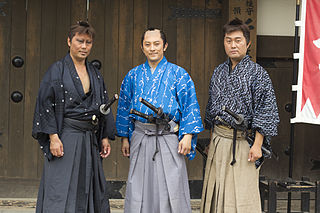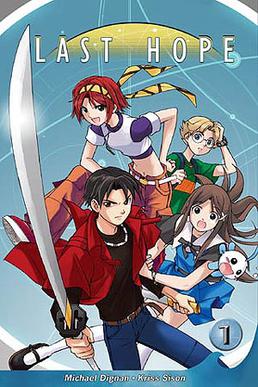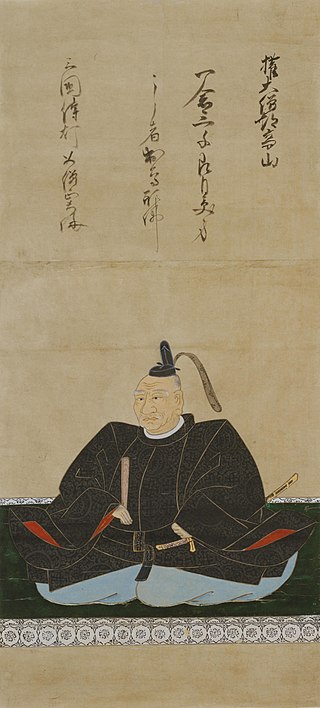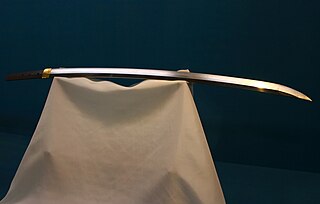
A Japanese sword is one of several types of traditionally made swords from Japan. Bronze swords were made as early as the Yayoi period, though most people generally refer to the curved blades made from the Heian period (794–1185) to the present day when speaking of "Japanese swords". There are many types of Japanese swords that differ by size, shape, field of application and method of manufacture. Some of the more commonly known types of Japanese swords are the uchigatana, tachi, ōdachi, wakizashi, and tantō.

A ninja or shinobi was an infiltration agent, mercenary, or guerrilla warfare and later bodyguard expert in feudal Japan. They often employed in siege espionage missions, and Military deception,. They were often appeared in the historical records during the Sengoku period, antecedents may have existed as early as the 12th century.

A tantō is one of the traditionally made Japanese swords that were worn by the samurai class of feudal Japan. The tantō dates to the Heian period, when it was mainly used as a weapon but evolved in design over the years to become more ornate. Tantō were used in traditional martial arts. The term has seen a resurgence in the West since the 1980s as a point style of modern tactical knives, designed for piercing or stabbing.

Shurikenjutsu (手裏剣術) is a general term describing the traditional Japanese martial arts of throwing shuriken, which are small, hand-held weapons used primarily by the Samurai in feudal Japan, such as metal spikes bō shuriken, circular plates of metal known as hira shuriken, and knives (tantō).

A kusarigama is a traditional Japanese weapon that consists of a kama on a kusari-fundo – a type of metal chain (kusari) with a heavy iron weight (fundo) at the end. The kusarigama is said to have been developed during the Muromachi period. The art of handling the kusarigama is called kusarigamajutsu.

Samurai Champloo is a 2004 Japanese historical adventure anime television series. The debut television production of studio Manglobe, the 26-episode series aired from May 2004 to March 2005. It was first partially broadcast on Fuji TV, then had a complete airing on Fuji Network System. It was licensed for North American broadcast on Adult Swim, and for commercial release first by Geneon Entertainment and later by Crunchyroll. It was also licensed for English releases in the United Kingdom by MVM Films, and in Australia and New Zealand by Madman Entertainment. A manga adaptation was serialized in Monthly Shōnen Ace during 2004, later released in North America by Tokyopop the following year.

Yabusame (流鏑馬) is a type of mounted archery in traditional Japanese archery. An archer on a running horse shoots three special "turnip-headed" arrows successively at three wooden targets.

Hachikō was a Japanese Akita dog remembered for his remarkable loyalty to his owner, Hidesaburō Ueno, for whom he continued to wait for over nine years following Ueno's death.

Jidaigeki is a genre of film, television, video game, and theatre in Japan. Literally meaning "period dramas", it refers to stories that take place before the Meiji Restoration of 1868.

Seven Seas Entertainment is an American publishing company located in Los Angeles, California. It was originally dedicated to the publication of original English-language manga, but now publishes licensed manga and light novels from Japan, as well as select webcomics. The company is headed by Jason DeAngelis, who coined the term "world manga" with the October 2004 launch of the company's website.

Last Hope is an original English-language manga series written by Michael Dignan, illustrated by Kriss Sison and published by Seven Seas Entertainment. Two volumes were published between 2005 and 2006. A third was planned but never released.

The Samurai is a Japanese historical fiction television series made by Senkosha Productions during the early 1960s. Its original Japanese title was Onmitsu Kenshi. The series premiered in 1962 on TBS and ran continuously until 1965 for ten self-contained story arcs (seasons), usually of 13 episodes each. Also created were two black-and-white feature films by Toei Company, made in 1964 by the same crew which created the TV series, and a stage show.
Fūma Kotarō was the name adopted by the leader of the ninja Fūma clan during the Sengoku era of feudal Japan. He was a retainer of the Later Hōjō clan. According to some records, his name was originally Kazama Kotarō.

Afro Samurai is a Japanese seinendōjinshi manga series written and illustrated by manga artist Takashi Okazaki. It was originally serialized irregularly in the avant-garde dōjinshi manga magazine Nou Nou Hau from November 1998 to September 2002. Inspired by Okazaki's love of soul and hip hop music and American media, it follows the life of Afro Samurai who witnessed his father, Rokutaro killed by a gunslinger man named Justice while he was a child. As an adult, Afro sets off to kill Justice and avenge his father.

Tōdō Takatora was a Japanese daimyō of the Tōdō clan from the Azuchi–Momoyama to Edo periods. He rose from relatively humble origins as an ashigaru to become a daimyō.

A katana is a Japanese sword characterized by a curved, single-edged blade with a circular or squared guard and long grip to accommodate two hands. Developed later than the tachi, it was used by samurai in feudal Japan and worn with the edge facing upward. Since the Muromachi period, many old tachi were cut from the root and shortened, and the blade at the root was crushed and converted into a katana. The specific term for katana in Japan is uchigatana (打刀) and the term katana (刀) often refers to single-edged swords from around the world.

The Yagyu Ninja Scrolls is a Japanese manga series adapted from the novel series Yagyū Ninpōchō written by Futaro Yamada and illustrated by Masaki Segawa. It was serialized in Kodansha's Seinen manga magazine Weekly Young Magazine from May 2005 to June 16, 2008, with its chapters collected in eleven tankōbon volumes as of August 2008. Its story centers on seven female survivors of the Hori clan, aided by Yagyū Jūbei, and their quest of vengeance.

Takashi Okazaki is a Japanese manga artist, visual designer and graphic designer, most notable for writing and illustrating the manga series Afro Samurai.
The Edo period of the history of Japan is the setting of many works of popular culture. These include novels, stage plays, films, television shows, animated works, manga, and video games. Major events of the period, such as the Siege of Osaka, Shimabara Rebellion, and the decline and fall of the Tokugawa shogunate figure prominently in many works. Historical and fictional people and groups of the period, including Miyamoto Musashi, Izumo no Okuni, Yagyū Jūbei Mitsuyoshi, the fictional Isshin Tasuke, Yui Shōsetsu, Matsuo Bashō, Tokugawa Mitsukuni, Ōoka Tadasuke, Tōyama Kagemoto, the Forty-seven Ronin, Sakamoto Ryōma, Katsu Kaishū, and the Shinsengumi, as well as the fifteen Tokugawa shoguns were active for much or all of their public lives and are dramatized in works of popular culture. The cultural developments of the times, including kabuki, bunraku, and ukiyo-e, and practices like sankin kōtai and pilgrimages to the Ise Shrine, feature in many works set in Edo Japan.

Rise of the Rōnin is a 2024 action-role playing game developed by Koei Tecmo's Team Ninja and published by Sony Interactive Entertainment. The game was released for the PlayStation 5 on 22 March 2024. Upon release, it received generally positive reviews from critics.


















